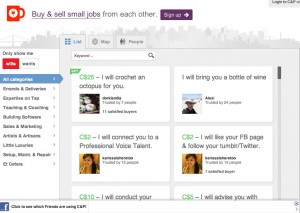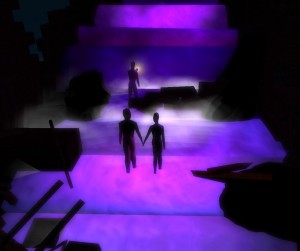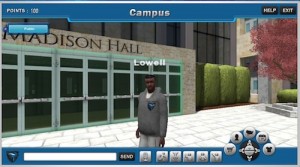Via Scoop.it – Metaverse News
Someone recently asked me to check with the Lab and ask about the “Big Marketing Push†that the Lab said at SLCC that it was gearing up for. If I recall rightly, the question was along the lines of “Has it happened yet?
Via dwellonit.taterunino.net
A marketing push
How Disney’s Club Penguin Became the Biggest Social Network for Kids
Via Scoop.it – Clinical Simulation
With more than 150 million profiles, Club Penguin might be the biggest social network for kids ever.
Via mashable.com
Beginning Content Creation In Second Life: the one-prim paperback
Via Scoop.it – Metaverse News
An introductory tutorial (first session) in content creation, produced for desktop VR students in the Faculty of Computing, Information Systems & Mathematics…
Via www.youtube.com
Grand Finale: UWA 3D Open Art Challenge
Once again the University of Western Australia’s Second Life presence has pulled off a brilliant Art Challenge, and for the second year in a row I’ve had the privilege of being a judge. This year there were a lot more entries, making the judging both more challenging and more fun. It also showcases the improvements to Second Life as far as the detail of art works submitted.
You can check out the list of finalists below, but first here’s a few visual snippets that stood out for me during the judging (click on image for the full size version):
Have a look for yourself – it’s a few hours very well spent.
Once again I’d like to thank the UWA’s Jayjay Zifanwe for the chance to play a small role in what remains one of the pre-eminent virtual worlds art installations in the world.
Finalists
FINALISTS FOR UWA 3D OPEN ART CHALLENGE OVERALL PRIZE
(in reverse Klingon alphabetical order):
ONE OF THESE ARTWORKS WILL WIN L$100,000
1. FLY WITH THE WIND by Josina Burgess
2. FOR YOUR VIEWING PLEASURE by Miso Susanowa
3. THE GLOWING SERPENT by Ginger Alsop
4. LAZER BALLS by Betty Tureaud
5. DREAM OF THE COLD SLEEPER by Typote Beck
6. IL PLEUT SUR MON COEUR COMME IL PLEUT SUR LA VILLE (“It’s raining in my heart, as it’s raining in the town”) by Cherry Manga
7. TRAVEL IN THE SHADOW OF TECHNOLOGY by Anley Piers
8. PARANORMAL FROTTAGE by Misprint Thursday
9. THE ILLUSIONIST by Gleman Jun
10. LIGHT TOWER by Betty Tureaud
11. TURNING THE TIDE by Nish Mip
12. CHOOSE YOUR BLOSSOM by Suzanne Graves
13. SYMPHONY IN THE BARREL OF A GUN by Arrow Inglewood
14. PLANET CENSORED by Anley Piers
15. STRANGE PLANT…UGLYNESS & BEAUTY by Claudia222 Jewel
16. THE RHYTHM OF MOOD – Lea Supermarine & Jarapanda Snook
17. DIGITAL GLOVE by Misprint Thursday
18. THE WILD WILD WORLD OF ILLUSION by RazorZ & Olga Soulstar
19. THE MINOTAUR OF CARTON by Typote Beck
20. ALICE’S ADVENTURES IN WONDERLAND by Cherry Manga
21. SHATTERED by Ginger Alsop
22. THE FRAGILITY OF THE SOUL IS NOT A DEFECT by Gleman Jun
23. SPANISH BULL by Silene Christen
24. TROIS PETITS TOURS ET PUIS S’EN VA (Three little turns and it goes away) by Josiane Sorciere
25. JUNGLE CHALLENGE by Dusty Canning
26. THE DOCK SPIRIT by Scottius Polke
27. ULTRA VIOLET by quadrapop Lane
28. THEATRE OF WAR by Miso Susanowa
29. VENUSTRAP by Claudia222 Jewell
30. ONE AND FOUR TIMEBOARDS by L1Aura Loire
31. UNE HORDE DE CORDES by Aristide Despres
32. 5×8 COMPUND CUBE by Wizard Gynoid
33. TIME AS A HELIX OF SEMI-PRECIOUS STONES by Miso Susanowa
34. THE HUMANICAL FROG by Lollito Larkham
35. HERE COMES THE SUN by Sledge Roffo
36. TV MORNING EXERCISES by Dusty Canning
37. PIUME DI PAVONE by Nino Vichan
38. DANGLING NARROW CHAIN DEMONSTRATOR by Emilin Nakamori
39. HARMONIES IN C GREAT (+) by Artistide Despres
40. NOT EVERYTHING IS PLAIN BLACK & WHITE by Fuschia Nightfire
41. LIVING FRACTAL by June Clavenham
42. THE MATTER OF IDEAS by Gleman Jun
43. THE SUPERHEROES BREAKFAST by Typote Beck
44. DOWN ON THE DATA FARM by Miso Susanowa
45. PETITE ETUDE SUR OLIVIER MESSIAEN by Artistide Despres
46. OMNIPOTENT by Pixels Sideways
47. THE CHASM by Oberon Onmura
48. EXCERPTS FROM REALITIES by Glyph Graves
49. THE ABANDONED DAUGHTER by Eliza Wierwight
50. YOU CAN’T TOUCH HEAVEN by paleIllusion
51. AUTUMN by nexuno Thespian
52. THE CROSSING by Nish Mip
53. FANTASIA EN LA SOMBRA by Romy Nayar
54. PRIMSCAPE DREAM by Sledge Roffo
55. 99% by Harter Fall
56. BLACK SHIRT by Misprint Thursday
57. IN DREAMS by Blue Tsuki
58. SWALLOWED UP BY THE CROWD by Fuschia Nightfire
59. L’IMPATIENCE by Josiane Sorciere
FINALISTS FOR THE NON-SCRIPTED PRIZE, UWA 3D OPEN ART CHALLENGE
1. THE COPPER BEECH by soror Nishi
2. LOSS by Gingered Alsop
3. MISS N by Suzanne Graves
4. DAUGHTER OF THE WIND by Fae Varriale
5. GECKO ON THE GEKKO by Yooma Mayo
6. SHATTERED by Ginger Alsop
7. THE FRAGILITY OF THE SOUL IS NOT A DEFECT by Gleman Jun
8. TRIBUTE TO GOYA by Silene Christen
9. MARIONETTE by Haveit Neox
10. HISTORY IN CREAM by Haveit Neox
11. FATA DANZANTE by Daco Monday
12. SPATIAL by Sledge Roffo
13. SPRING BOX by Cherry Manga
14. TRUST by spirit Radikal
15. TUNNEL WITH LIGHT AT THE END OF IT by RazorZ
16. HURDLE by Corcosman Voom
17. BEHIND COLUMNS by Harter Fall
18. BIRDSONG by Cherry Manga
19. YOU CAN’T TOUCH HEAVEN by paleIllusion
20. STILL LIFE by soror Nishi
21. 99% by Harter Fall
22. THE REVOLT OF THE MANNEQUINS by Silene Christen
23. USED PIECES by Secret Rage
24. SMALL PIECE OF HELL, The Suicide Forest Infested by Harpias by Rebeca Bashly
The Watch – virtual worlds in the news
 1. Sydney Morning Herald (Australia) – Little big online world. “Sydney’s Bubble Gum Interactive has built a colourful new online world for kids they describe as a “virtual playground”. Screen Play recently caught up with Paul Gray, director of marketing and community management at the studio to chat about their new venture and issues like the challenges of raising funds for such an ambitious project, the difficulty of convincing parents that it is a safe space for their kids, and the balance between entertainment and education.”
1. Sydney Morning Herald (Australia) – Little big online world. “Sydney’s Bubble Gum Interactive has built a colourful new online world for kids they describe as a “virtual playground”. Screen Play recently caught up with Paul Gray, director of marketing and community management at the studio to chat about their new venture and issues like the challenges of raising funds for such an ambitious project, the difficulty of convincing parents that it is a safe space for their kids, and the balance between entertainment and education.”
2. She Knows (USA) – Virtual World Games Tweens and Teens Love. “If your child has outgrown Club Penguin and Webkinz, consider some of these popular virtual worlds suited for tweens. You should always check out a virtual world website before letting your child participate and use parental controls if available and necessary.
Ty Girlz — Geared toward tween and teen girls, this virtual world site is unlocked with the purchase of a Ty Girlz doll. Inside Ty Girlz, your daughter will find cool apartments, clothes, makeovers and games.
Wizard101 — Kids who love Harry Potter adore Wizard101. This massively multiplayer online role-playing game (MMORPG) allows players to start as a novice wizard and then accept quests, collect gold and gain equipment as they aim to save the Spiral.
Stardoll — Based on the concept of paper dolls, Stardoll is a virtual world where players dress up dolls, participate in games, create clubs, socialize with friends and more. This popular virtual world website features over 124 million users.
SecretBuilders — Players immerse themselves in virtual lands, undertake quests, maintain a home, play games and interact with friends. SecretBuilders features stories, themes and characters (both historical and fictional figures) from literature, art and the humanities.”
3. Search Engine Watch (USA) – Mixed Signals in Second Life & Virtual Worlds: Buzz is All Over the Map. “There’s been no shortage of news and buzz in the past two weeks as regards Second Life and virtual worlds in general. Usually, though it all tends in one direction. It’s either good, or bad depending on what’s going on. Interestingly, though, this time, it’s all over the place. I guess if you average it all out it’s the same as it ever was, which is probably not the worst thing in the world. But hey, let’s just lay it out there and you decide.”
4. The Drum (UK) – Dramaforum appoints Dubit to create virtual world. “Finnish publisher Dramaforum has appointed virtual world development studio Dubit to develop a virtual world for its Petra’s Planet franchise. The virtual world will be based on children’s book series Petra, which follows a young girl transported to different countries – such as Senegal, Sri Lanka, Samiland, and Jordan – through her mother’s magical theatre wardrobe.”
5. Huffington Post (UK) – Virtual Worlds and ‘Intimate Computing’: the Future of Digital Play. “The recent story of human-digital interactions is one of steadily increasing closeness: we are moving from merely ‘personal’ computing to something that you might call ‘intimate’ computing. Modern smartphones and tablets, with their touchscreens and their constant presence in our lives, are extensions of our selves in a way that no digital device was even a decade ago. They are the channels through which we interact with even the most important people in our lives. They are where we work and play; where we hang out with friends. They are the first thing many of us touch when we wake in the morning and the last when we go to bed at night. Our relationship with technology is, it seems to me, one that’s increasingly governed by the dynamics of leisure and play. We have an incredibly satisfying sense of control when we are plugged into the best digital tools – and, increasingly, a gnawing sense of anxiety when we are unplugged. There is the pleasure of the most serious kind of play: the agency that comes from transforming the world into a kind of game, full of achievements, progress and certainties.”
6. PopMatters (USA) – Is Virtual the New Reality? “My Second Life avatar walks unsteadily across the screen. She moves in stops and starts as I clumsily direct the keys. I’m new at this game, unsure what I’m supposed to do with her and where should I go. I scan the suggested destinations in the Second Life universe and head over to “Londonâ€, where I once studied abroad in my real life. As my avatar navigates the somewhat familiar streets of this virtual London, I wonder about the reality of what I’ve entered. I am an outsider here, a novice explorer in this virtual realm. Though I sit alone at my computer, in the game I’m surrounded by others. Dispersed across the digital sprawl, these gamers are all invested in the shared reality of Second Life. What is this virtual world I am entering into all about? Am I simply playing a game, or am I entering a new reality?”
7. Wired (USA) – Army Wants Virtual Training to Really Hurt. “The military’s newest digital training system is gonna open a can of whoop-ass on new recruits. And maybe a sonic blaster, too. The use of gaming technology, from first-person shooters to virtual worlds, is quickly becoming the military’s mode of choice for training the troops of this generation. But those digital proving grounds come with one major disadvantage: They just don’t hurt enough. That could be about to change, according to a new request for proposals issued by the Army last week, which calls for technology to “create an impulse force that simulates the feel of debris… or bullet strikes.†The request, called “Haptic Feedback for a Virtual Explosion,†certainly sounds like fodder for a new videogame blockbuster. At least until you find your virtual self on a mysterious, dark road, abandoned buildings to both sides, the wind whipping your hair and — KABOOM! — owwwwwwww, getting shot hurts! That’s kinda the idea: Make training as realistic as possible, by giving soldiers a taste of exactly what they should be bracing for in combat. Bombs and bullets, unfortunately, need to be included.”
8. Stuff.co.nz (New Zealand) – Kiwi company gets Disney backing. “A mix of serendipity and word of mouth turned out to be the catalysts for Disney to invest in a virtual-world company founded by a couple of Kiwi blokes. Mitch Olson and Darren Green weren’t actively looking for investment in their start-up Small Worlds, when they attended a virtual worlds conference in San Jose at the beginning of 2008. But by chance, Olson bumped in to a Disney executive who was looking to invest in companies. Olson and Green explained their vision to him and six months later the world’s largest media group had injected funds in to their virtual baby, and Small Worlds was born.”
9. Delaware News Journal (USA) – Unlock your virtual potential. “Basked in the glow of the computer humming quietly in her living room, Kimberly Winnington is creating worlds limited only by imagination. Within those worlds, people can fly effortlessly, explore endlessly. They can discover new experiences, learn things they never knew, all without leaving their chairs or stepping outside of their homes. Winnington is in the business of bringing people — and other businesses — into a digital world that she believes has been largely ignored. Working with partners located in faraway states, she has the capability of creating three-dimensional programs that allow real-world people — students, or even a business’s customers — to walk, talk and even interact.”
10. Sky News (UK) – Investigation: Paedophilia And Second Life. “Five years ago it seemed as if the whole internet might be swallowed by virtual worlds. Imagine: you can change your age, colour and sex. Avatars can buy clothes, own houses purchased with money convertible to currency in the real world, and yes, have virtual sex with each other. Eight million people inhabited one virtual world called Second Life. The possibilities for wrongdoing were very real. So when my editor asked me to create an avatar and investigate crime in this virtual world, it was not long before one user contacted me with a disturbing tale. Her avatar, called Harmony, was a winged angel. We met on a virtual island where she told me about the Second Life place called “Wonderland”. “It’s a paedophile ring,” she said. “They do all sorts of dreadful things.” Wonderland was a candy-coloured children’s playground with a mix of child and adult avatars. The adults were tall and domineering, the children petite but sexually attired in mini-skirted school uniforms.”
Philip Rosedale spruiks new venture, talks down Second Life?
 If you’ve followed the exploits of Linden Lab’s former CEO and current Chairman over the past year or so, you’ll know he’s been off creating something new. The New York Times has run a profile on that venture, Coffee and Power.
If you’ve followed the exploits of Linden Lab’s former CEO and current Chairman over the past year or so, you’ll know he’s been off creating something new. The New York Times has run a profile on that venture, Coffee and Power.
That venture seems interesting enough and leverages heavily the virtual currency model used for Second Life, in this case to purchase or receive payment for goods or services.
It’s very similar to a bunch of other services, though it seems a solid community is already being built up. Whether you need a garden gnome restored, someone to crochet an octopus for you or a Powerpoint presentation created for you, it can all be purchased.
What interested me most however, was this paragraph:
While he is still chairman of Linden Lab, the company that created Second life, Mr. Rosedale talks about that venture in the past tense.
“The problem with creating an immersive 3-D experience is that it is just too involved, and so it’s hard to get people to engage,†he said. “Smart people in rural areas, the handicapped, people looking for companionship, they love it. But you have to be highly motivated to get on and learn to use it.â€
Assuming the quote is accurate, is that the message you want coming from the Chairman of your Board? There’s nothing in the statement I’d disagree with factually, but it still seems an interesting approach from someone who’s been aligned with Second Life from the beginning.
Over to you: a skewed story or an indication of malaise at the very top of Linden Lab?
‘3D Virtual Campus Tours’ gains traction
I had a note from Andrew Hughes, Adjunct Instructor at the University of Cincinatti and head honcho of Designing Digitally Inc, on the success to date of their 3D Virtual Campus Tours product. Mirror worlds are of course well established and were one of the original ways universities and business have utilised virtual worlds.
Universities in particular are an obvious market, in that new students have a genuine interest in learning how to find their way around, to which virtual environments are ideally suited to help out.
I shot some questions back to Andrew Hughes to get some more information on where 3DVCT sees itself in the marketplace and where it sees its unique value is.
Q: What was the original impetus to develop specifically for campus tours?
A: We have built over 30 campuses inside Second Life, Opensim, and other virtual worlds only to find that we’re not thinking about the convenience factor for novice users. On the web we give around 2 seconds for a website to load before we move on. We were looking to build a browser-based campus and it just so happened that the United States Air Force Academy was looking for a virtual campus tour that was online and completely a browser based replica of their campus. We won the contract and have built a browser-based high end campus tour with built in communication tools and live and AI guided tours.
Q: What sort of response have you had to date from universities, including international universities?
A: We launched the product in March of this year. With the build we have done with the United States Air Force Academy, they have had four thousand recruits through the space at this current time. We have a handful of Universities both in the USA and outside the USA we’re building now but we are under NDA’s with them and cannot disclose their name, the nature of the campus’s needs etc until they are launched on the client’s website.
Q: We have a lot of readers who are educators: can you give a little insight on the platform 3DVCT is built on, including how easy it would be to implement at a university with more restricted IT infrastructure?
A: We’re using the Unity 3D gaming engine and a complex MMO system that is connected to a dynamic server or servers. The development of the system has a complete content management system for users, history, macros for the tours, and even the ability to control the AI bot and what she says within the CMS. The databases are able to fully integrate into an existing CRM or ERM software used by the university so that there is one streamlined process.
We work hard to learn the process from day one of a potential student to the date he or she signs up for the first class. We then build the system to be as integrated and as easy as possible for the University. We also have extensive experience in building in Unity 3D to the extent that we’ve been quoted by their CEO for our talents. The reason I state this as we can change the ports used to adhere to the client’s specifications. We also can cloud the system so that it loads faster and is a little less processor heavy on the end user.
Q: Obviously it will vary but can you give a ballpark cost for a standard university campus tour from development to implementation? And how do you think this compares to other options in the marketplace?
A: Our company is very good at what we do and so we’re in line with any other completely custom built browser-based virtual MMO developer. We also do pricing per enrollment size. So a smaller college will get a discounted rate depending on the pricing of the current student enrollment. Right now there is not a virtual world focused on just giving virtual campus tours. Right now in the industry other virtual campus tours are 360 panoramas or Google overhead maps. An experience like that won’t let the student see how big the dorm room is compared to his or her size, nor would it allow them to actually walk around a to-scale campus to see where everything is and get familiar with the campus by actually walking around in it or talking to a live admin rep through voice and text chat we have built in.
Our virtual space is built in the high end gaming engine called Unity 3D and has had over two years of R&D built into it, so that the process can be done quickly and at a professional level you cannot get from Second Life or any other virtual world out there.
Q: What arguments would you make for your platform as opposed to say a university going it alone and developing an OpenSim grid on which to mirror their university and conduct tours?
A: We have the ability to do the following, unlike the virtual worlds you speak of above:
1. Full AI Technology
2. Control over the avatar experience
3. Custom ability to change ports
4. Higher quality of development
5. Runs in a web browser
6. Does not have a large learning curve to get into the world
7. Fully customizable both interface, experience, branding, etc.
8. Ability to be skinned and placed on your website for full ownership
9. Full content management system for the ability to control bots, users, history user tracking where they were, etc.
This is far beyond what those other platforms could ever do – I state this as we’re well known for our SL and Opensim builds and we found that we cannot recruit students effectively.
Q: What are Designing Digitally’s plans for the coming year?
We are working on 3D training simulations, and virtual worlds for government and corporate clients. Many of them are either under NDA or classified government projects. We will be launching a financial literacy system for people to learn how to manage money, buying houses, etc. This will include both Flash and Unity simulations within it. We are also going to be going to the following conferences:
– ASTD 2012
– SALT 2012
3DVCT will be at:
– Noel-Levitz 2012
– NACAC 2012
———-
So there you have it – the 3DVCT product has hitched its wagon firmly to the Unity3D platform, an obvious trend in the simulation field in particular. For what it’s worth, the time I spent checking out 3DVCT further reinforced to me the responsiveness of Unity3D. It’s not the panacea for everything but it’s dominating some key virtual world niches – which lays down a significant challenge to competitors. That can only be good for the ongoing evolution of the industry.
Will Wright joins Linden Lab Board of Directors (and a quick Sims Social review)
 I had to have a bit of a smile when I saw Tateru Nino’s story on The Sims’ creator Will Wright joining the Linden Lab board.
I had to have a bit of a smile when I saw Tateru Nino’s story on The Sims’ creator Will Wright joining the Linden Lab board.
Over the past week I’ve been playing The Sims Social, the Facebook-based version of the game. I’d argue it’s actually one of the least social versions of the game in that there is no live interaction with your Facebook friends and it’s a flurry of more traditional Facebook Wall posts and messages between your friends to achieve key parts of the game.
Not surprisingly with a Facebook-based social game, there’s a heavy push towards virtual currency (SimCash), and it’s not cheap:
Sure, you can play most aspects of the game without buying SimCash (there’s also Social Points and Simoleons that you accumulate and spend), but it takes an active effort to play that way. I can’t blame Electronic Arts for wanting to make money, but I think the slant is too heavy. There’s plenty of depth in the game although there’s a heavy feeling of the MMO grind or familiar endless Farmville grind you’ll be very used to. That classic Sims humour is still present and overall I’m enjoying playing although I think that interest may wane fairly quickly.
Anyway, back to Will Wright. He obviously has no active role with The Sims anymore and I wasn’t able to find any direct comments he’s made on The Sims Social, so I hope he’ll not be part of a drive to implement such a constraining social model on Second Life. I’m more assuming he’ll bring some new ideas that don’t rely on tried and true models – Second Life needs to remain unique whilst improving / evolving. The more brain-power on the Board to help that along the better.
That said, if Simlish becomes the new primary language of Second Life, I’m leaving.
The Watch – virtual worlds in the news
 1. Sydney Morning Herald (Australia) – Study’s the name of the game. “Inside a school laboratory, students gather around the bench for today’s lesson: how to create a chemical reaction. Yet instead of turning to their worksheets, these young investigators try some role play. Each budding scientist dons a lab coat and begins to experiment until – voila! – beakers erupt all over the room. Their reward? Not a mark or score but a handful of special tokens. The student who makes the biggest explosion also wins the title of professor. Welcome to the world of ”gamification”, where schooling looks less like a conventional classroom and more like a game of World of Warcraft. The concept is simple: that game mechanics such as virtual currency, puzzles and point systems could one day become as common in schools as tests, pens and textbooks.”
1. Sydney Morning Herald (Australia) – Study’s the name of the game. “Inside a school laboratory, students gather around the bench for today’s lesson: how to create a chemical reaction. Yet instead of turning to their worksheets, these young investigators try some role play. Each budding scientist dons a lab coat and begins to experiment until – voila! – beakers erupt all over the room. Their reward? Not a mark or score but a handful of special tokens. The student who makes the biggest explosion also wins the title of professor. Welcome to the world of ”gamification”, where schooling looks less like a conventional classroom and more like a game of World of Warcraft. The concept is simple: that game mechanics such as virtual currency, puzzles and point systems could one day become as common in schools as tests, pens and textbooks.”
2. Search Engine Watch (USA) – Linden Lab Must Stop Tinkering With Our Income. “The number of times I’ve had a discussion revolving around the reality vs. unreality of virtual worlds are uncountable. You can have this discussion really about any topic. Any activity that you can do in both RL and in a Virtual World is fair game. Of course, everyone has their own lines as to what is “real” and what is alternatively, SL, VW, or “just a hyped up video game”. However, for me, the one thing that is undeniably real is the money. A virtual world economy using real money is for all intents and purposes a real economy. Since the money can be converted to real world cash, any distinction is trivial.”
3. Red Eye Chicago (USA) – Gaming gone indie. “It sounds at first like the nerdiest season of “The Real World” MTV never taped: Six guys, all recent DePaul graduates from the video game development program, stuffed themselves, some laptops, Xboxes and other worldly possessions into a modest five-bedroom apartment in North Center. Aside from exchanging dirty jokes and a few other shenanigans, the arrangement that began in July is as much about business as pleasure. “The Corral,” as they’ve affectionately nicknamed their living room, doubles as the office of Young Horses—a brand new video game studio. The mission: to finish their aquatic pet project “Octodad 2″—a wacky adventure game about an octopus that masquerades as a regular human father—by the end of their one-year lease in July 2012.”
4. Expert Reviews (UK) – Blizzard Sells Off Pieces of Its Virtual World. Blizzard Entertainment, the creators of World of Warcraft, are selling off old hardware in aid of St. Jude Children’s Research Hospital in Memphis, Tennessee. The ‘world’ of World of Warcraft is actually composed of a large number of Realms – identical copies of the game world running on separate hardware. This helps to keep the load on individual servers to a manageable level so that users can play the game smoothly, but it also means that if you want to play with friends, you have to choose the same realm when you start the game. Having recently upgraded WoW’s servers, Blizzard has decided to auction off the old servers. These are in the form of “blades” – single circuit boards that contain all the hardware necessary for a server, including processors, memory and storage. Each realm is powered by a number of blades, to provide redundancy in the case of a failure in a single blade.”
5. Sydney Morning Herald (Australia) – Power of thought moves limbs. “A brain implant that allows monkeys to move an avatar’s arm and feel objects in a virtual world has been demonstrated for the first time. The animals used the device to control the arm by thought alone, and feel the texture of objects through electrical signals sent directly to the brain. Researchers built the system to help paralysed people regain the use of their arms and legs, and feel the objects they touched and the ground they walked on.”
6. Huffington Post (USA) – Spiritual Sex in an Increasingly Virtual World. “I believe most modern Americans have a very low capacity for pleasure. I don’t just mean sex. I mean being tactile, receiving touch, feeling the wind rush past your body, swimming, getting in bed at night and rolling around in your clean sheets for a few minutes. Tactile pleasure makes us more whole. I believe we all need sensual touch every day. It’s highly important for me to tune into the subtleties of sensation in my body. It’s transformational, and I can bring it into my life 24/7, from writing an article to having a business meeting. I can be present and involved, wanting to expand everything I do to its most delicate and exquisite place — because that’s what I practice during sex. As I just suggested, there are other ways to find that capacity, but sex works for me.”
7. Fast Company (USA) – Kinect TV And Sesame Street Hack The Next Generation Of TV. “Xbox is unveiling a sharp idea for the next generation of television: interactive, live-action content, produced in partnership Sesame Workshop and National Geographic. Downloadable, linear episodes run like a normal television show but give children opportunities to play simple games with familiar characters and don virtual costumes that mold to their bodies and play around with the show’s environment. A series of interactive children’s books is also in the works. Dubbed “Project Columbia,†they allows burgeoning readers to explore the otherwise static world of a picture books with games, sounds, and augmented reality.”
8. ABC News (USA) – Herman Cain’s 9-9-9 Plan Similar to SimCity’s Virtual Tax Plan. “Whether it came from a pizza box or an unnamed Wells Fargo banker, Herman Cain’s 9-9-9 economic plan is now being compared to another unlikely source: the SimCity video game. Long before the GOP presidential candidate’s plan began dominating the political discourse, a shockingly similar 9-9-9 plan was ruling the virtual world of SimCity. In the video game, residents of SimCity 4 pay default taxes that include a 9 percent commercial tax, a 9 percent industrial tax and a 9 percent residential tax, Huffington Post Politics pointed out. Cain’s plan implements a 9 percent sales tax, 9 percent personal income tax and 9 percent corporate income tax.”
9. Success Magazine (USA) – The Future Is Now: Virtual Office Reality. “The idea of stepping into a hologram for a monthly staff meeting may still seem a tad far-fetched for most small-business owners, but improvements in broadband quality and available technology are expanding virtual meeting options at warp speed. Yet, even in the virtual world, it’s best to take a hard look before you leap. Whether you’re NASA conjuring the holodek of Star Trek science fiction to train astronauts, or a fledgling entrepreneur struggling to communicate with remote partners or customers, the first step into the burgeoning virtual world should be doing your homework to find the most appropriate and cost-effective solution for you. First, here’s a primer on the available technology.”
10. Los Angeles TImes (USA) – Businesses quickly adopting augmented reality apps for consumers
. “You point your smartphone at an Italian restaurant, and diner reviews of its lasagna pop up on-screen. Or you aim your tablet computer’s camera down a residential street, and over images of the houses you see which ones are for sale — along with the asking price, number of baths and square footage. Haven’t done this yet? You probably will soon. The technology is called augmented reality, or AR, and businesses are racing to incorporate it in as many consumer applications as they can. It’s essentially the same technology TV sportscasts use to digitally paint a first-down line on a football field, adapted and updated for camera-equipped smartphones and tablet computers. “In the future, you’ll be able to point your device at anything around you and, without prompting, that device will recognize what is there, incorporate your interests, and layer on information about what you’re looking at,” said Brian Blau, research director at Gartner Inc. “Point a phone at a building, you’ll see the history, for example. Or at a flower, the kind of flower comes up.”
On the fly 3D surface reconstruction: KinectFusion
Microsoft’s Kinect is rightfully getting a lot of attention from researchers. One snippet that caught my attention is a collaboration between Microsoft and a number of UK and Canada-based researchers. The result is KinectFusion.
Have a look for yourself:
The implications for virtual worlds are fairly obvious. The thing that particularly struck me is the dynamic capability of the approach even at this early stage – if something changes with the physical world environment, it is reflected virtually. For the education, science and health fields, to name three, this is huge.
One obvious example within my pet area of clinical simulation: a camera (with consent) is placed in a busy emergency department in a large teaching hospital. Emergency nursing students based at a rural university receive that feed, had it convert on the fly to 3D for use within their virtual learning environment. Students may actually ‘work’ a full shift virtually, needing to respond to the challenges of the changing environment as they occur.
As I said, there’s a long way to go (for starters, KinectFusion is about surfaces only), but the progress is rapid and exciting. Over to you: what applications could you see this being good for?
- « Previous Page
- 1
- …
- 10
- 11
- 12
- 13
- 14
- …
- 165
- Next Page »









Recent Comments